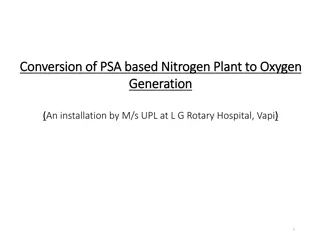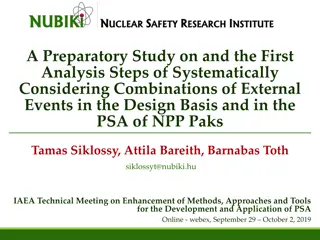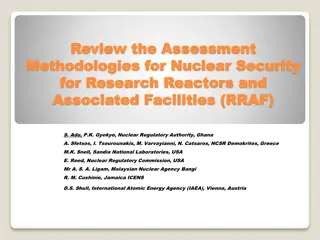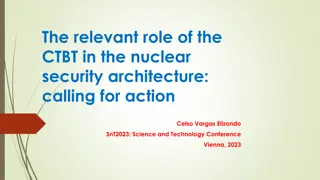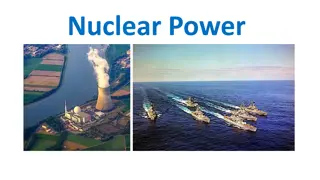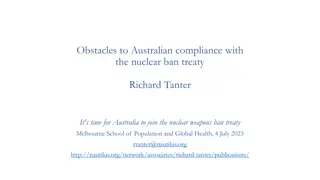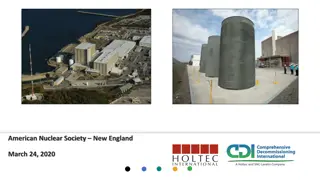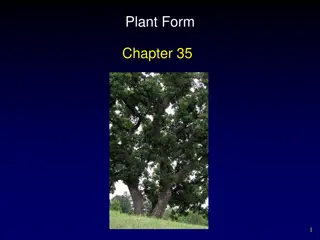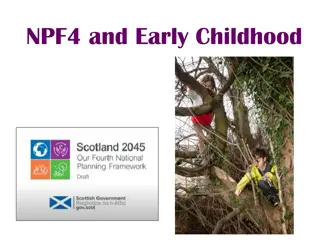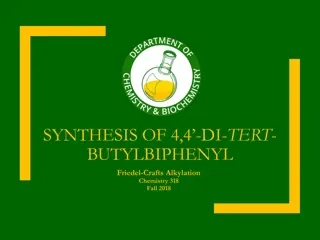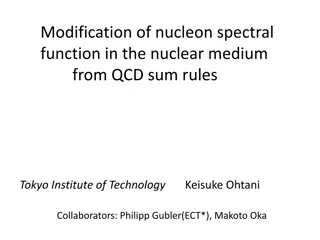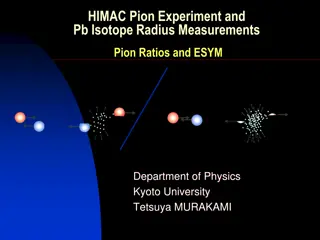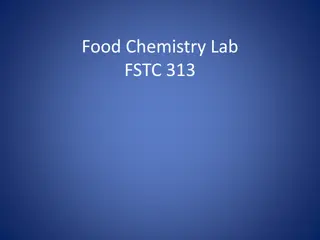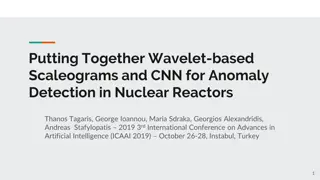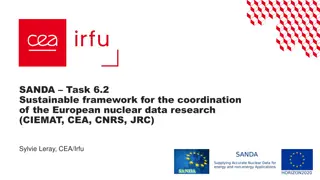Development and Primary Application of Level 2 PSA Methodology in Small Nuclear Plant Design Analysis Lab
The study at the LabRisco in University of São Paulo, Brazil focuses on developing and applying a Level 2 Probabilistic Safety Assessment methodology for a small nuclear plant design evaluation. The work entails identification of severe accident scenarios, analysis of nuclear systems, and constructing event trees and fault trees. The objective is to model a loss of coolant circulation accident in a Small Modular Reactor (SMR) during low power and shutdown states. The methodology involves several steps such as accident sequence analysis, occurrence frequency assessment, and LERF calculation. Specific severe accident scenarios and their frequencies in the SMR's LPSD are also outlined.
Download Presentation

Please find below an Image/Link to download the presentation.
The content on the website is provided AS IS for your information and personal use only. It may not be sold, licensed, or shared on other websites without obtaining consent from the author. Download presentation by click this link. If you encounter any issues during the download, it is possible that the publisher has removed the file from their server.
E N D
Presentation Transcript
Development and Primary Application of a Level 2 PSA Methodology in a Small Nuclear Plant design Analysis, Evaluation and Risk Management Laboratory (LabRisco) University of S o Paulo - Brazil Nath lia N. Ara jo, nathalia.nunes@labrisco.usp.br Maritza R. Gual, maritza.gual@labrisco.usp.br Ulisses A. M. Neto, ulisses.neto@labrisco.usp.br Marcos C. Maturana, marcos@labrisco.usp.br Marcelo R. Martins, mrmartin@usp.br 1
Summary Introduction and objetive Methodology Identification of severe accident scenario Nuclear systems Results - event tree and fault tree Final remarks 2
Introduction The Probabilistic Safety Assessment (PSA) consist of a comprehensive and structured method of quantitative safety and risk assessment. In nuclear industry, the PSA are performed for three different levels, from fuel damage to possible radiological release. PSA Levels At each level, the risk associated with the indicated event is analyzed 2 : Radioative Leak 1 : Core Damage 3 : Dose 3
Introduction Small and medium-sized reactors (SMR) are smaller than conventional reactors and are designed to produce up to 300 MWe. A nuclear plant has two main operating states: full power and low power and shutdown (LPSD). In Brazil, the Nuclear Regulatory Commission does not have specific PSA standards or recommendations for SMR. SMRs Typical Reactor 4
Objective The main objective of the work is to define the scope of the modelling of a Level 2 PSA in the study of a loss of coolant circulation accident in the LPSD in an SMR. The reference SMR is a two-loop pressurized water reactor (PWR) with an electrical capacity of 10 MWe. 5
Methodology Level 2 PSA STEP 3 STEP 4 STEP 2 STEP 6 STEP 1 STEP 5 Final states of accident sequences and related occurrence frequences Accidents Sequence Sub-PDS (Plant Damage States) Source Terms analyses Accident progression- Containment event trees Calculation of the LERF (Large Early Release Frequency) Release category identification Accident grouping process Filtering of low Frequency PDSs Selected PDSs 6
Severe Accident scenario Percentage of CDF in the LPSD Group number Frequency of CDF(/yr) Event Main characteristics Loss of coolant circulation in the SFP Loss of coolant circulation in the SFP Loss of coolant circulation in the reactor core Fuel transfer, part of the fuel in the SFP 1 2.54E-06 5.60% All fuel in SFP 2 2.54E-05 55.98% All fuel in the reactor core. Reactor vessel head closed Fuel transfer, part of the fuel in the reactor core. Reactor vessel head open 3 1.46E-05 32.14% Loss of coolant circulation in thereactor core 4 2.85E-06 6.28% 7
Severe Accident scenario Percentage of CDF in the LPSD Group number Frequency of CDF(/yr) Event Main characteristics Loss of coolant circulation in the SFP Loss of coolant circulation in the SFP Loss of coolant circulation in the reactor core Fuel transfer, part of the fuel in the SFP 1 2.54E-06 5.60% All fuel in SFP 2 2.54E-05 55.98% All fuel in the reactor core. Reactor vessel head closed Fuel transfer, part of the fuel in the reactor core. Reactor vessel head open 3 1.46E-05 32.14% Loss of coolant circulation in thereactor core 4 2.85E-06 6.28% 8
Nuclear systems ADS Automatic Depressurization System B Pump CIS Coolant Injection Subsystem HIS H2 Inertization System V Valve PZR Pressurizer TC Heat Exchanger 9
Nuclear systems AD Automatic Depressurization System B Pump CIS Coolant Injection Subsystem HIS H2 Inertization System V Valve PZR Pressurizer TC Heat Exchanger 10
Assumptions Due to a lack of operational experience, some data used for failure rates were obtained from generic industry data, published probabilistic risk assessment data from similar nuclear power plants, and NUREG/CR-6928. All component failures are considered repairable. Steam generators are not available for emergency cooling. The RHRS is identified as the second-highest contributor with respect to core damage from the system in the LPSD (for the reference design). The top common cause of failure (CCF) is the RHRS pumps B01 and B02 failing to run. 11
Fault Tree 13
Event tree Recovery of RHRS H2 control and mitigation Contaiment Integrity Loss of Coolant Circulation in the reactor Reactor Cooling System AD Valves Sequence 1 Sequence 2 Sequence 3 Sequence 4 Sequence 5 Computer Aided Fault Tree Analysis (CAFTA) 14
Event tree 8.27E-04 1.46E-05 6.54E-05 To be defined To be defined Recovery of RHRS H2 control and mitigation Contaiment Integrity Loss of Coolant Circulation in the reactor Reactor Cooling System AD Valves OK Sequence 1 No release of FP to enviroment Sequence 2 No release of FP to enviroment Sequence 3 Release of FP to enviroment Sequence 4 Sequence 5 Release of FP to enviroment Computer Aided Fault Tree Analysis (CAFTA) 15
Final remarks The data obtained in this paper allowed the preliminary calculation of the frequency of sequence 1, 1.30E-05 /yr. From this data, it is possible to determine that the sum of the frequency of the other sequences is less than 1.56E-06/yr, which represents important information to the large early frequency release (LERF). These results are preliminary, considering the methodology is under development, and for future studies, the event and fault trees will be improved to generate more results and expand the research. The analysis of the loss of coolant circulation in the reactor core due to the failure of the RHRS with all the fuel in the reactor core and in the closed reactor vessel head in an SMR project demonstrated the need for further investigation in the study of safety and emergency systems 16
THANK THANK YOU YOU! ! 17





